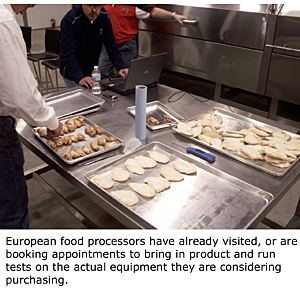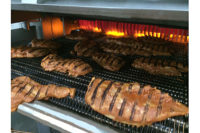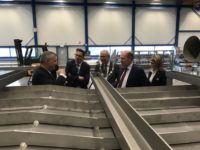Product yields, throughput, food safety and more labor- and energy-efficient ways to address increasingly diverse consumer preferences are concerns of food  processors throughout Europe.
processors throughout Europe.
To address those issues, Unitherm Food Systems Inc., a Bristow, Okla., manufacturer of advanced thermal cooking, pasteurizing and chilling/freezing systems, inaugurated a leading-edge test kitchen in Maastricht, Netherlands, that enables processors seeking productivity and quality improvements to conveniently see and test the latest systems for cooking protein, vegetables and bakery products.
“This facility demonstrates many of the most efficient technologies for processing foods that many European consumers are looking for today,” says Bartosz Psiuch, director of food processing equipment distributor Alimp, Mys?owice, Poland. “It creates a highly promising opportunity for large and small processors to try out systems that have never been seen before in Europe, and can enable them to better service their markets, whether ready-to-eat, foodservice or institutional.”
Situated within a proximity of Europe’s capital cities (e.g. 55 minutes from Dusseldorf, Brussels or Cologne), the Maastricht test kitchen is an easy daytrip for most processors located on the continent via train, air or even automobile. Examples of system capabilities include inline smoking and browning, small footprint “spiral” ovens and continuous pasteurizing and grilling of vegetables such as onions and peppers. The equipment is arranged in in-line configurations, so that processors can experience how continuous systems fit and work together.
“Many European companies are producing snack items such as chicken wings,” says Francisco Sierra, European business manager at the Netherlands plant. “They want to develop a product with a very nice color using their own recipes, whether teriyaki-style wings, Buffalo-style wings or any other flavor. Using our spiral oven, they can achieve that while at the same time increasing their yields substantially. It takes considerable labor and time to load those trays. In total, each batch takes about 50 minutes, on average. But, using a continuous cooking line, that same amount of chicken will likely take about 20-22 minutes. This system maximizes the effects of color development and minimizes shrink. So, productivity is increased, quality and yield are improved and the cost of labor is reduced.”
Another advanced system that processors can execute at the new Maastricht facility is infrared inline smoking and browning.
“This will be a breakthrough to European companies that use a traditional process for smoking ham,” says Sierra. “We can literally say, ‘What is taking you five hours, you can now do in 60 seconds,’ through inline smoking and browning.”
In addition, a flame grill with what is said to contain the most ribbon burners in the industry produces authentic bar-marks for a flame-grilled appearance, and a newly released machine called the Tunnel of Fire can flame roast chicken in 30 seconds. A Unitherm flame pasteurization system helps vegetable processors peel onions, for example, in a more mechanical process, thus reducing onion weight by 25-30%.
The mission of the Maastricht test kitchen is to provide processors with the opportunity to view new thermal cooking technologies and to gain hands-on experience through the use of the equipment to test run their own products, says David Howard, chief executive officer of Unitherm.
“The future of purchasing food processing machinery is going this way, where the customer can demand to go into a kitchen and actually try out their product on the machinery,” says Howard. “Only then can they feel confident that the equipment best serves their operational parameters and expected results.”


